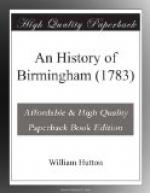The Britons had a very slender knowledge of fortification. The camps they left us, are chiefly upon eminences, girt by a shallow ditch, bordered with stone, earth, or timber, but never with water. The moat, therefore, was introduced by the Romans; their camps are often in marshes; some wholly, and some in part surrounded by water.
These liquid barriers were begun in England early in the christian aera, they were in the zenith of their glory at the barons wars, in the reign of king John, and continued to be the mode of fortification till the introduction of guns, in the reign of Edward the fourth, which shook their foundation; and the civil wars of Charles the first totally annihilated their use, after an existence of twelve hundred years.
Perhaps few parishes, that have been the ancient habitation of a gentleman, are void of some traces of these fluid bulwarks. That of Birmingham has three; one of these, of a square form, at Warstone, erected by a younger brother of the house of Birmingham, hath already been mentioned; it is fed by a small rivulet from Rotton Park, which crosses the Dudley Road, near the Sand pits.
Another is the Parsonage house, belonging to St. Martin’s, formerly situated in the road to Bromsgrove, now Smallbrook street, of a circular figure, and supplied by a neighbouring spring. If we allow this watery circle to be a proof of the great antiquity of the house, it is a much greater with regard to the antiquity of the church.
The third is what we simply denominate the Moat, and was the residence of the ancient lords of Birmingham, situated about sixty yards south of the church, and twenty west of Digbeth; this is also circular, and supplied by a small stream that crosses the road to Bromsgrove, near the first mile stone; it originally ran into the river Rea, near Vaughton’s hole, dividing the parishes of Birmingham and Edgbaston all the way, but at the formation of the Moat, was diverted from its course, into which it never returned.
No certain evidence remains to inform us when this liquid work was accomplished: perhaps in the Saxon heptarchy, when there were few or no buildings south of the church. Digbeth seems to have been one of the first streets added to this important school of arts; the upper part of that street must of course have been formed first: but, that the Moat was completed prior to the erection of any buildings between that and Digbeth, is evident, because those buildings stand upon the very soil thrown out in forming the Moat.
The first certain account that we meet with of this guardian circle, is in the reign of Henry the Second, 1154, when Peter de Birmingham, then lord of the see, had a cattle here, and lived in splendor. All the succeeding Lords resided upon the same island, till their cruel expulsion by John Duke of Northumberland in 1537.
The old castle followed its lords, and is buried in the ruins of time. Upon the spot, about forty years ago, rose a house in the modern style, occupied by a manufacturer (John Francis;) in one of the out-buildings is shewn, the apartment where the ancient lords kept their court leet; another out-building which stands to the east, I have already observed, was the work of Edmund Lord Ferrers.




